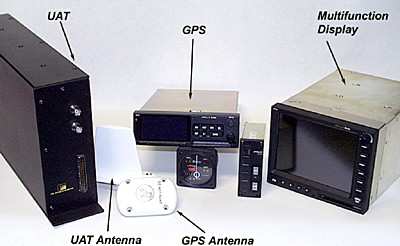Three Contractors To Bid On Implementation
 This week, the FAA signed off
on the next phase of its Automatic Dependent Surveillance-Broadcast
(ADS-B) Program.
This week, the FAA signed off
on the next phase of its Automatic Dependent Surveillance-Broadcast
(ADS-B) Program.
ADS-B, the backbone of the agency's planned Next Generation Air
Transportation System (NextGen), received FAA approval on February
21 to proceed toward the next phase of implementation. The
agency’s Joint Resources Council (JRC), a team of top FAA
executives that reviews major acquisitions, approved funding for
nationwide deployment of ADS-B.
NextGen is the FAA’s plan to transform the nation’s
airspace system through 2025, primarily by transitioning from a
ground-based system to a satellite-based system. The agency calls
ADS-B the cornerstone for this transformation, by bringing the
precision and reliability of satellite-based surveillance to the
nation’s skies.
The FAA states With real-time situational awareness in the
cockpit, aircraft will be able to fly closer together, resulting in
a significant increase in airspace capacity. The JRC approved
segment two of ADS-B implementation, which runs from 2009 to
2014.
The JRC also approved moving the Alaska Capstone project into
the national ADS-B program, as well as expanding Capstone services
within the state. Alaska, the location for the operational
evaluation of ADS-B and other aviation safety services, saw a
dramatic reduction in its fatal accident rate -- and the FAA states
it will increase efforts to bring Capstone technology to the more
remote areas of the state.
The FAA states that through combining Capstone with the national
ADS-B program, the agency will ensure development of the Alaska
aviation infrastructure will be on par with the national
infrastructure as developed in the lower 48 states.
The JRC also validated cost savings resulting from the ADS-B
back-up plan, which was finalized late last year. The back-up plan
calls for maintaining 50 percent of the secondary radars, which
will provide air traffic services in case of a loss or degradation
of the GPS signal. The FAA says this move will allow the agency to
remove 50 percent of its current secondary radars, saving money in
the program’s baseline.

The ADS-B program office released a Screening Information
Request on November 30, 2006, in order to solicit vendors seeking a
contract award. A review of the submitted proposals was completed
and three vendors were selected to participate in further
acquisition activities leading to the contract award. They are ITT
of McLean, VA; Lockheed Martin of Rockville, MD, and Raytheon of
Marlborough, MA.
In July, after the contract is negotiated, the JRC will review
the business model in the proposed contract. Based on a successful
JRC investment decision, the agency will award the contract for
establishing the ADS-B ground infrastructure and providing
broadcast services. This will be a performance-based contract in
which the FAA will pay “subscription” charges for the
ADS-B services and the vendor will be responsible for building and
maintaining the infrastructure.

In June 2006, the ADS-B program received JRC approval for
segment one, along with funding for 2007 and 2008. In segment one,
the FAA will install ADS-B at Philadelphia, Louisville, and Juneau;
and install new stations on oil and gas platforms in the Gulf of
Mexico, where there is no radar surveillance. Segment one also
includes the expansion of ADS-B broadcast services along the East
Coast, throughout North Dakota, and along the lower part of the
U.S. to Arizona and through Southern California. In addition, it
involves the development of ADS-B separation standards and software
to interface between ADS-B and other air traffic control
systems
 ANN's Daily Aero-Term (12.13.25): Light Gun
ANN's Daily Aero-Term (12.13.25): Light Gun Aero-News: Quote of the Day (12.13.25)
Aero-News: Quote of the Day (12.13.25) NTSB Final Report: Gippsland GA-8
NTSB Final Report: Gippsland GA-8 Classic Aero-TV: Historically Unique -- Marlin Horst's Exquisite Fairchild 71
Classic Aero-TV: Historically Unique -- Marlin Horst's Exquisite Fairchild 71 Airborne 12.12.25: Global 8000, Korea Pilot Honors, AV-30 Update
Airborne 12.12.25: Global 8000, Korea Pilot Honors, AV-30 Update





